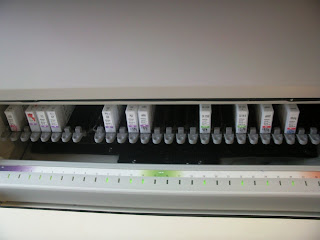Week 14
It’s the 14th week already. 6 more weeks to go. Hope you guys are doing fine. =)
Last week I mentioned about faecal extraction. So now, after the extraction has been done, we can now measure the glucocorticoid level.
To measure the glucocorticoid levels in the faecal sample, radioimmunoassay (RIA) is used. Just to refresh your memory. The principle of RIA is based on the competition between unlabelled ligand and a fixed amount of radiolabelled ligand for a limit amount of antibody. The proportion of the bound labelled ligand is inversely related to the concentration of the unlabelled ligand.
An essential step in RIA is the separation of the unbound radiolabelled ligand from the Ab-Ag complexes. This is done so that the unbound radiolabelled ligand will not interfere with the counting and hence cause inaccurate result. However, this step can make the whole RIA procedure to be time consuming and can be prone to human error due to additional steps needed as compared to using SPA.
What is SPA?
SPA refers to scintillation proximity assay that makes use of SPA reagent to eliminate the separation step. The SPA reagent contains either a secondary antibody or protein A that is bound to a fluomicrosphere. The fluomicrosphere will produce light if it is bound to a radiolabelled ligand. Light will not be produced if the SPA reagent is bound onto an unlabelled ligand. Unbound radiolabelled ligand will also not produce light.

To calculate the concentration of the unlabelled ligand, a machine called the scintillation counter is used. Depending on what kind of isotope used, the scintillation counter can vary. If a beta emitting isotope is used, a beta-scintillation counter will be used and if a gamma emitting isotope is used, a gamma-scintillation counter will be used. The scintillation counter will calculate the amount of radiolabelled ligand by detecing the light and then using a software, the concentration of unlabelled ligand can be determine by interpolating from a standard curve. By detecting only the light produced by bound radiolabelled ligand, this eliminate the need for the separation step.

Again, depending on whether a beta emitting radioisotope is used or a gamma emitting isotope is used, the shield could vary. Beta emitting isotopes are weakly penetrative, hence, a plastic shield is sufficient enough to block the rays. In fact, a piece of paper is already enough to block off the beta-rays. Gamma emitting isotope such as iodine 125 is more penetrative. Hence, when using 125I, we are expected to work behind a metal shield. Also, as the rays emitted can be absorbed through skin, gloves as to be wore at all times!
And of course, we will have controls to ensure that our results are valid.
As the steps involved in carrying out the RIA is quite long, I will just give a brief outline on what is done. When measuring different ligands, different set of standard concentration, antibody and tracer will be used. Hence, for illustration, I will focus on cortisol.
First we have to prepare our standards so that a standard curve can be plotted.
6 standards are prepared with concentration consisting of 188, 375, 750, 1500, 3000 and 6000 fmol/0.1ml by serial dilution starting from the standard of the highest concentration. FYI, the standard with the highest concentration is already pre-prepared by the staff in the lab.
After which, we need to prepare the SPA reagent and antibody mixture and also the 3H cortisol tracer.
Because the controls used are in serum, there is also a need for the extraction of steroids as the steroids will be bound to its binding globulin. In this case, we don’t extract the steroids like what was done on the faeces. The controls are first diluted in distilled water and then heated at 60oC for 30 minutes. The heating is sufficient to dissociate the steroids from its binding globulin.
Next, we will dilute the faecal samples 50x. After which, 100 µl of standards, PBS, faecal samples and controls will be aliqouted into another set of test tube. PBS is used to measure the total binding of the radiolabelled ligand to the SPA reagent. 200 µl of SPA reagent and antibody mixture is then added to all tubes followed by 100 µl of 3H cortisol tracer.
The test tubes are then incubated overnight (18-24h), followed by counting it in the scintillation counter.
That’s all. Hope you guys understand. I know, the post is very long. Oops. x_x
Xin Yi
TG02









